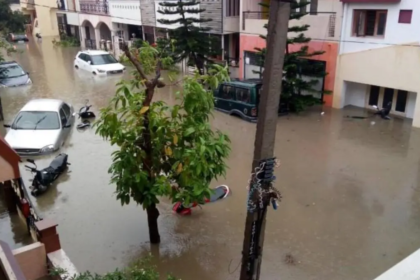Direct Answer
- The Yamuna River in Delhi can likely be cleaned with sustained effort, but success depends on BJP’s implementation post their 2025 win.
- Early actions show promise, like deploying machinery and a master plan, but challenges like untreated sewage and industrial waste remain.
- It seems likely that with coordination and funding, significant progress is possible, though full cleanup may take years.
Background
The Yamuna, vital to Delhi, is heavily polluted, with 80% of its contamination occurring in a 22-km stretch through the city. The BJP, after winning the 2025 Delhi elections, made cleaning the river a key promise, launching efforts shortly after.
Yamuna Ghat Delhi | Yamuna Ghat Delhi Vlog | Yamuna Ghat Boating | Exclusive Yograj (Source – Youtube)
Recent Efforts
Post-election, on February 16, 2025, the BJP started cleanup with trash skimmers and weed harvesters, focusing on waste removal and drain cleaning. The Jal Shakti Ministry prepared a ‘Yamuna Master Plan’ for PM Modi’s approval, aiming for a three-year cleanup, drawing from the Sabarmati model.
Challenges Ahead
Untreated sewage, industrial compliance, and upstream flow issues pose hurdles. Experts note unauthorized colonies and public behavior as key barriers, suggesting a complex, long-term effort.
Outlook
While early steps are encouraging, success hinges on sustained funding, agency coordination, and public support. It seems likely that with commitment, the river can improve, but full restoration may take beyond three years, given historical failures.
Comprehensive Analysis of Delhi Yamuna Cleaning Efforts Post-BJP’s 2025 Election Win
The Yamuna River, a sacred lifeline for millions and a critical ecological asset for Delhi, has long been mired in pollution, with its waters turning into a toxic mix of sewage, industrial effluents, and agricultural runoff. The Bharatiya Janata Party (BJP), following their historic win in the Delhi Assembly elections in February 2025, has positioned the cleanup of the Yamuna as a flagship initiative, promising to restore its glory within three years. This analysis delves into the recent efforts, political context, challenges, and prospects, drawing from available data and expert insights to assess whether the BJP can deliver on this ambitious pledge.
The State of the Yamuna: A River in Crisis
The Yamuna enters Delhi at Wazirabad relatively clean but exits at Okhla as one of the most polluted urban rivers globally. Approximately 80% of its pollution load occurs in just 2% of its length—the 22-km stretch through Delhi—where the city contributes 79% of the total contamination. Daily, Delhi dumps over 3.5 billion liters of sewage into the river, with only about 40% treated adequately. Industrial units add heavy metals like chromium, while agricultural runoff and cultural practices, such as idol immersions, exacerbate the problem. The river’s biochemical oxygen demand (BOD) often exceeds 70 mg/l, far above the safe limit of 3 mg/l, rendering it biologically dead in many stretches, with toxic foam and zero dissolved oxygen becoming common sights.
BJP’s Election Promise and Immediate Action
Cleaning the Yamuna was a central plank of the BJP’s 2025 election manifesto, with promises to collaborate with the central government to develop a modern riverfront and establish a dedicated fund, the Yamuna Kosh, for restoration. During the victory celebrations on February 8, 2025, Prime Minister Narendra Modi reiterated his commitment, stating, “We will not let Yamuna remain filthy now that the BJP government has arrived”. True to their word, the BJP wasted no time, launching cleanup operations on February 16, 2025, under the directive of Delhi Lieutenant Governor VK Saxena.
The initial efforts employed a four-pronged strategy, detailed in Table 1 below, to address immediate pollution sources and lay the groundwork for long-term restoration:
| Strategy Component | Description |
|---|---|
| Removing Waste and Silt | Deploying trash skimmers, weed harvesters, and dredge utility crafts to clear the main stream. |
| Cleaning Major Drains | Focusing on significant polluters like Najafgarh Drain and Supplementary Drain. |
| Monitoring Sewage Treatment Plants (STPs) | Daily assessments to ensure maximum efficiency and functionality. |
| Expanding Treatment Infrastructure | Developing a time-bound plan for new STPs to address a 400 MGD sewage shortfall. |
Multiple agencies, including the Delhi Jal Board (DJB), Irrigation & Flood Control Department (I&FC), Municipal Corporation of Delhi (MCD), Environment Department, Public Works Department (PWD), and Delhi Development Authority (DDA), are coordinating these efforts. The Delhi Pollution Control Committee (DPCC) is tasked with ensuring no untreated industrial effluents enter the drains, aiming to plug a critical leakage point.
The Yamuna Master Plan: A Comprehensive Approach
Beyond these immediate actions, the central government has prepared a ‘Yamuna Master Plan’ to tackle the pollution crisis in mission mode, as reported on February 27, 2025. Spearheaded by the Jal Shakti Ministry, this plan is set to be submitted to Prime Minister Narendra Modi for approval, signaling a high-level commitment. The plan draws inspiration from the successful rejuvenation of Gujarat’s Sabarmati River, consulting experts involved in that project. Key components include:
- Waste Removal: Clearing silt and pollutants from the riverbed to improve water quality.
- Drain Cleanup: Targeting major drains that feed into the Yamuna, addressing a significant pollution source.
- STP Oversight: Ensuring all STPs operate at full capacity, with strict monitoring to prevent untreated sewage discharge.
- Infrastructure Expansion: Building new STPs to handle Delhi’s growing sewage load, particularly from unauthorized colonies not currently connected to the sewerage network.
This master plan aims to provide a structured, long-term framework, contrasting with past ad-hoc efforts like the Yamuna Action Plan launched in 1993, which spent billions but failed to lower BOD levels significantly.
Political Context and Public Engagement
The Yamuna’s cleanup has been a political flashpoint, with both the BJP and the Aam Aadmi Party (AAP) making it a campaign issue in 2025. The BJP’s victory, however, shifted the narrative, with the Supreme Court expressing hope for better efforts under the “changed circumstances” in Delhi during a February 26, 2025, hearing. Symbolically, Delhi Chief Minister Rekha Gupta and her cabinet performed a Yamuna aarti at Vasudev Ghat, a gesture shared widely by the Delhi BJP to underscore their dedication and engage the public emotionally.
Historical context reveals challenges, with the momentum for cleaning the Yamuna starting in January 2023 when the National Green Tribunal (NGT) formed a High-Level Committee (HLC) under LG Saxena. However, the AAP government obtained a stay from the Supreme Court on July 10, 2023, halting the committee’s work, which led to a surge in pollution levels, as evidenced by high chemical oxygen demand (CoD) and BOD. The BJP’s current efforts aim to overcome this political deadlock, leveraging central government support and a unified approach.
Challenges and Expert Insights
Despite the promising start, cleaning the Yamuna remains a monumental task. Experts, such as Susmita Sengupta from the Centre for Science and Environment, emphasize that efforts will not succeed unless the government addresses untreated sewage from unauthorized colonies, a vast population segment not connected to the sewerage network. Industrial compliance is another hurdle, with many units bypassing effluent treatment norms. Upstream issues, such as reduced flow due to dams like Hathni Kund, limit the river’s ability to dilute pollutants, requiring coordination with neighboring states like Haryana.
Public behavior also poses a challenge, with cultural practices like idol immersions and waste dumping contributing to pollution. The BJP’s target to clean the river within three years is ambitious, especially given historical failures. The NGT has expressed anguish over past governments’ inability to implement directives related to STP capacity, treated wastewater quality, and floodplain restoration, highlighting systemic gaps that the current government must address.
Future Outlook and Prospects
The BJP’s early actions, including deploying machinery and formulating a master plan, are encouraging. The involvement of multiple agencies and the central government’s backing suggest a more coordinated approach than previous efforts. However, success hinges on sustained funding, effective implementation, and public buy-in. If the BJP can maintain momentum, leverage the Sabarmati model, and tackle root causes like untreated sewage and industrial waste, significant progress is likely. Yet, full restoration may take beyond three years, given the scale of pollution and historical precedents.
For Delhiites, who have watched their sacred river deteriorate for decades, this is more than an environmental issue—it’s about reclaiming a piece of their cultural and historical identity. The city’s eyes are on the BJP, hopeful yet cautious, as they embark on this journey to revive the Yamuna, potentially marking 2025 as a turning point.















